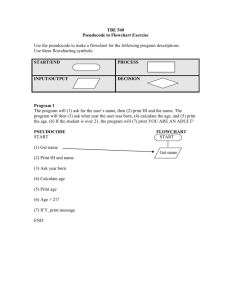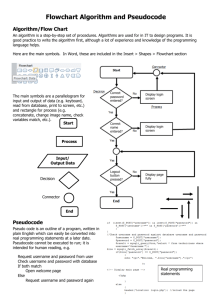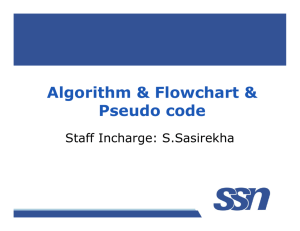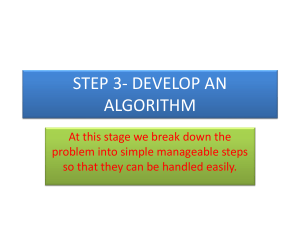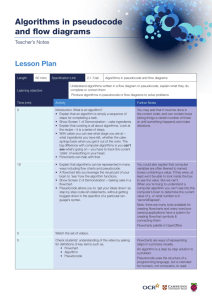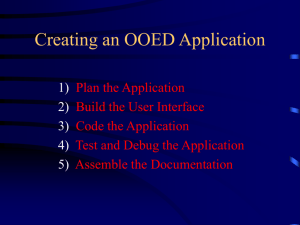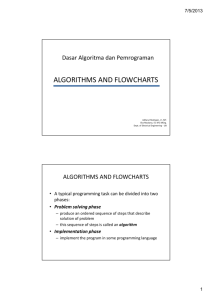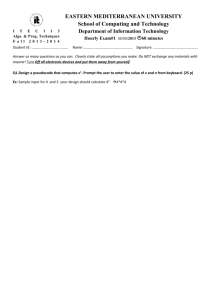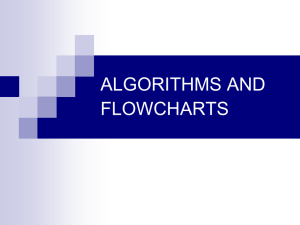C | 3. Algorithm and Flowchart
advertisement
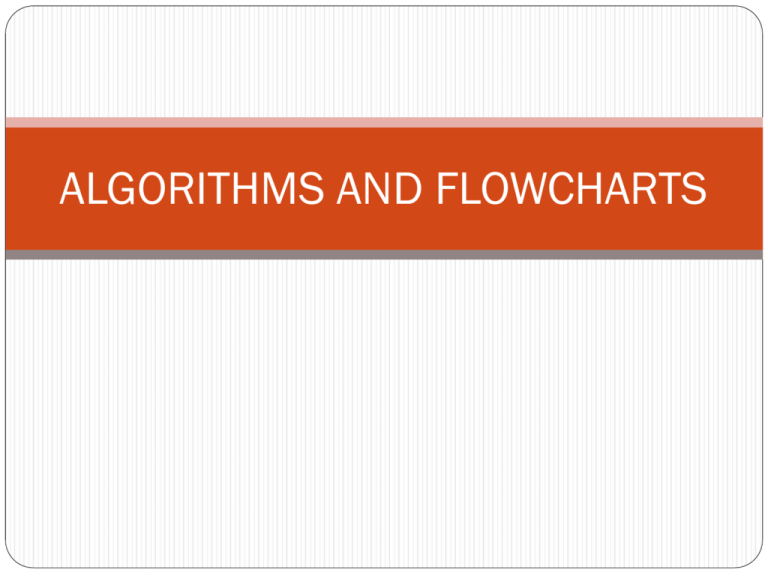
ALGORITHMS AND FLOWCHARTS Why Algorithm is needed? Computer Program ? Set of instructions to perform some specific task Is Program itself a Software ? NO, Program is small part of software. Software merely comprises of Group of Programs (Source code), Code: refers to statements that are written in any programming language as machine code or C code. • Code is some time interchangeably used with program. 2 Why Algorithm is needed? • Programming is both tedious and exciting. Tedious because like spoken languages programming languages also have so many demanding rules. Exciting because writing program provides the programmer with the chance to create something new also gives challenges of solving a problem. It is very difficult to write direct programs in any language, just like you can not start constructing building without the design of building. For constructing a building you need design of building, similarly for writing a large or good program you need algorithm. 3 Program design Problem Algorithm Program Program Design Process has 2 phases: Problem Solving Phase Creates an algorithm that solves the problem Implementation (Coding) Phase Translates the algorithm into a programming language 4 Algorithms An algorithm is a finite set of steps defining the solution of a 5 particular problem. Need not to belong one particular language Sequence of English statements can also be algorithm It is not a computer program An algorithm can be expressed in English like language,called pseudocode, in a programming language or in the form of flowchart. Algorithm Vs Program What is the difference between an algorithm and a program? a program is an implementation of an algorithm to be run on a specific computer and operating system. an algorithm is more abstract – it does not deal with machine specific details – think of it as a method to solve a problem. • What is good algorithm? Efficient algorithms are good, we generally measure efficiency of an algorithm on the basis of: 1. Time: algorithm should take minimum time to execute. 2. Space: algorithm should use less memory. 6 Algorithm Specification Every algorithm must satisfy the following criteria: Input. Zero or more quantities are externally supplied. Output. At least one quantity is produced. Definiteness. Each instruction must be clear and unambiguous(Unique meaning). Finiteness. An algorithm terminates in a finite number of steps. Effectiveness. Every instruction must be basic enough to be carried out than, means not so complex. 7 Pseudo code Pseudocode is one of the methods that could be used to represent an algorithm. It is not written in a specific syntax that is used by a programming language and therefore cannot be executed in a computer. There are lots of formats used for writing pseudocodes and most of them borrow some of the structures from popular programming languages such as C, Lisp, FORTRAN, etc. Also, natural language is used in Pseudocode when presenting details that are not important. Most of the algorithms are presented using pseudocode since they can be read and understood using programmers who are familiar with different programming languages. Some programming constructs used for Pseudo Code – READ, PRINT, SET, INITIALISE, INCREMENT, IF – THEN – ENDIF, IF – THEN – ELSE – ENDIF,REPEAT – UNTIL, DO – WHILE etc. 8 What is the difference between Algorithm and Pseudocode? An algorithm is a well defined sequence of steps that provides a solution for a given problem, while a pseudocode is one of the methods that can be used to represent an algorithm. While algorithms can be written in natural language, pseudocode is written in a format that is closely related to high level programming language structures. But pseudocode does not use specific programming language syntax and therefore could be understood by programmers who are familiar with different programming languages. Additionally, transforming an algorithm presented in pseudocode to programming code could be much easier than converting an algorithm written in natural language. 9 Informal definition of an algorithm 10 Finding the largest integer among five integers 11 Defining actions in Find Largest algorithm 12 ALGORITHM REPRESENTATION 13 Example 1 Write an algorithm that finds the average of two numbers Solution: AverageOfTwo Input: Two numbers 1. Add the two numbers 2. Divide the result by 2 3. Return the result by step 2 2 End 14 Example 2 Write an algorithm to change a numeric grade to a pass/fail grade. Solution: 1. 2. 15 Pass/FailGrade Input: One number if (the number is greater than or equal to 40) then 1.1 Set the grade to “pass” else 1.2 Set the grade to “fail” End if Return the grade End Example 3 Write an algorithm for grading System of JUET. Marks range >=80 >=70 & <80 >=60 & <70 >=50 & <60 <50 16 Grade A B C D F Solution Algorithm for Grading AlgoForGrade Input: One number 1. if (the number is between 80 and 100, inclusive) then 1.1 Set the grade to “A” End if 2. if (the number is between 70 and 79, inclusive) then 2.1 Set the grade to “B” End if Continues on the next slide 17 3. if (the number is between 60 and 69, inclusive) then 3.1 Set the grade to “C” End if 4. if (the number is between 50 and 59, inclusive) then 4.1 Set the grade to “D” End if 5. If (the number is less than 50) then 5.1 Set the grade to “F” End if 6. Return the grade End 18 Dr. Vishnu Sharma Example 5 Write an algorithm to find the largest of 1000 numbers. Solution FindLargest Input: 1000 positive integers 1. 2. 3. 4. Set Largest to 0 Set Counter to 0 while (Counter less than 1000) 3.1 if (the integer is greater than Largest) then 3.1.1 Set Largest to the value of the integer End if 3.2 Increment Counter End while Return Largest 19 End Flowchart A graphical representation of an algorithm, often used in the design phase of programming to work out the logical flow of a program. Visual way to represent the information flow Make our logic more clear Help during writing of program Make testing and debugging easy 20 21 Flowchart or program constructs Sequence:The order of execution, this typically refers to the order 22 in which the code will execute. Normally code executes line by line, so line 1 then 2 then 3 and so on. Selection: Selection, like branching, is a method of controlling the execution sequence, you can create large control blocks, using if statements testing a condition, or switch statements evaluating a variable etc to control and change the execution of the program depending on this environment and changing variables. Iteration (Repetition): Iteration is typically used to refer to collections and arrays of variables and data. Repeating set of instruction. Counting from 1 to 10, you are iterating over the first 10 numbers. for, while, do-while loops will be implemented for iteration. Flowchart Constructs 23 Flowchart Constructs (cont..) 24 Flowchart Constructs (cont..) 25 Example-1 Write an algorithm and draw a flowchart that will read the two sides of a rectangle and calculate its area. Algorithm Step 1: Take Width and Length as input Step 2: Calculate Area by Width* Length Step 3: Print Area. Example-1 Pseudocode Step 1: Input W,L Step 2: AL x W Step 3: Print A START Input W, L A LxW Print A STOP Example-2 Write an Pseudocode and draw a flowchart that will take marks of four subjects and calculate the average.Then if average marks are greater than 50 then print PASS otherwise print FAIL. 28 Example-2 START Input M1,M2,M3,M4 AVG(M1+M2+M3+M4)/4 N IS AVG<50 Print “PASS” Y Print “FAIL” STOP Step 1: Input M1,M2,M3,M4 Step 2: AVG (M1+M2+M3+M4)/4 Step 3: if (AVG <50) then Print “FAIL” else Print “PASS” endif Example 3 Write an algorithm and draw a flowchart to convert the length in feet to centimeter. Algorithm: Input the length in feet (Lft) Calculate the length in cm (Lcm) by multiplying LFT with 30 Print length in cm (LCM) Example 3 Pseudocode Step 1: Input Lft Step 2: Lcm Lft x 30 Step 3: Print Lcm Flowchart START Input Lft Lcm Lft x 30 Print Lcm STOP Example 4 Write an algorithm and draw a flowchart that will calculate the roots of a quadratic equation ax 2 bx c 0 Hint: d = sqrt ( b 2 4ac ), and the roots are: x1 = (–b + d)/2a and x2 = (–b – d)/2a Example 4 Algorithm: Input the coefficients (a, b, c) of the quadratic equation Calculate d Calculate x1 Calculate x2 Print x1 and x2 START Example 4 Input a, b, c Pseudocode: Step 1: Input a, b, c Step 2: d sqrt ( b b 4 a c ) x1 (–b + d) / (2 x a) x2 (–b – d) / (2 x a) Print x1, x2 Step 3: Step 4: Step 5: d sqrt(b x b – 4 x a x c) x1 (–b + d) / (2 x a) X2 (–b – d) / (2 x a) Print x1 ,x2 STOP Example 5 Write an algorithm that reads three numbers and prints the value of the largest number. Example 5 Step 1: Input N1, N2, N3 Step 2: if (N1>N2) then if (N1>N3) then MAX N1 //[N1>N2, N1>N3] else MAX N3 //[N3>N1>N2] endif else if (N2>N3) then MAX N2 //[N2>N1, N2>N3] else MAX N3 //[N3>N2>N1] endif endif Step 3: Print “The largest number is”, MAX Flow Charts Limitation For very large program, flow chart goes for many pages Costly to draw flow charts for large program Difficult to modify 37
